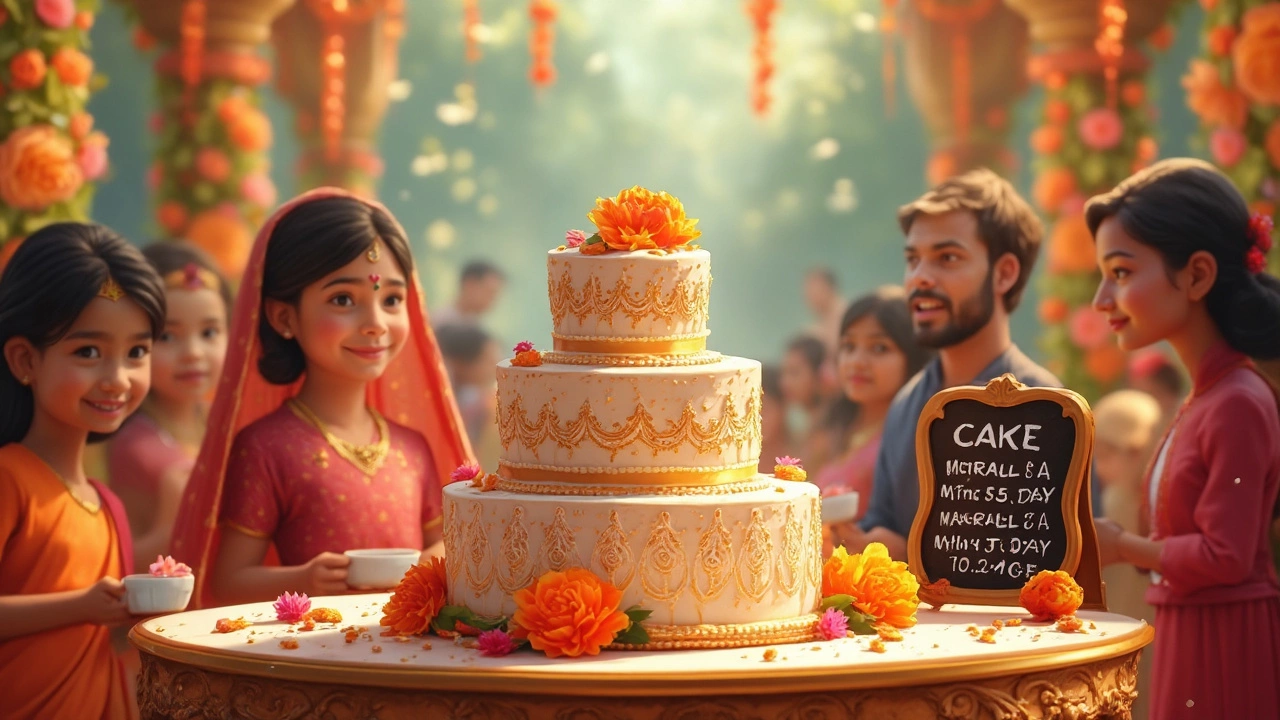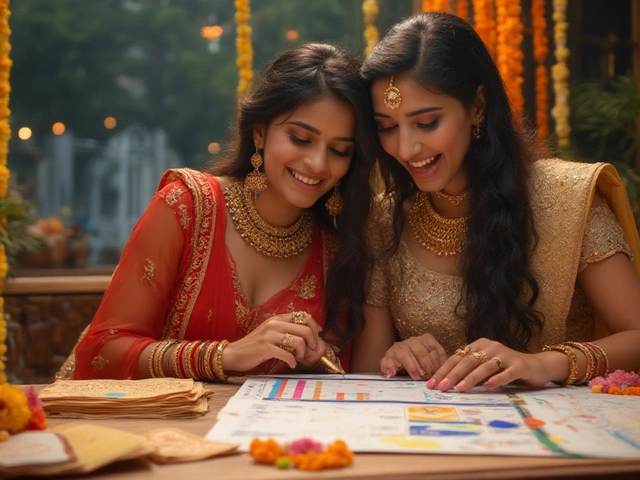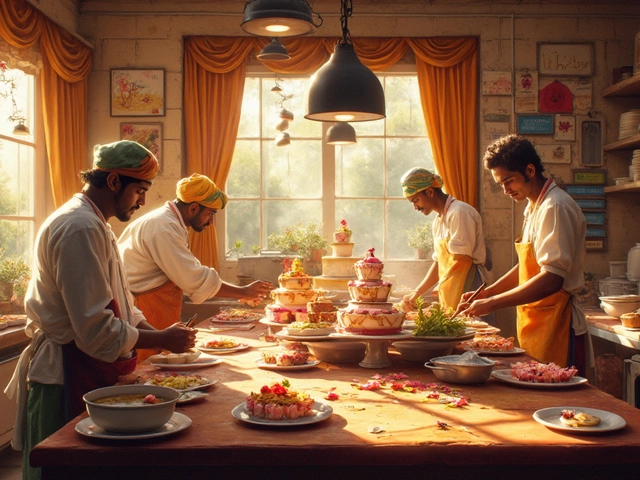
Trying to figure out the right size for a 3 tier wedding cake? You’re not alone. I remember standing in the bakery hunched over a calculator, wondering if our cake was going to feed everyone or if Gareth and I would end up hoarding leftovers for months. When you’re knee-deep in wedding plans, cake sizes start to feel more like math homework than dessert dreams.
Here’s the first thing to remember: cake size isn’t just about looking impressive. It has to actually feed your guests—without going overboard (or running out). The numbers on those ordering sheets? They matter, but so does the type of event you’re hosting. Guests don’t always eat a full slice, but no one wants to leave people wishing for more.
- Why Cake Size Matters More Than You Think
- Standard 3 Tier Combinations and How Many They Feed
- Matching Cake Size to Your Guest List
- Common Cake Sizing Mistakes to Avoid
- Tips From Professional Cake Makers
- Making It Personal: Customizing Your Cake Size
Why Cake Size Matters More Than You Think
Choosing the right 3 tier wedding cake size doesn’t just come down to looks. It’s all about making sure every guest gets a proper serving, not wasting money, and avoiding last-minute panic if you run short. Wedding cakes aren’t cheap, and cake makers usually charge by the slice, so picking the right size affects your budget and your peace of mind on the big day.
Ever wonder why the cake size can be a hot topic? Here’s why it really matters:
- You want every guest to feel included. Running out of cake is one of those awkward moments that no couple wants.
- Going too big means paying for cake that just sits in everyone’s freezer (which, let’s be honest, gets tossed after a month).
- Proper sizing keeps your wedding planning on track—neither overspending nor stressing about portions.
Most pro bakers estimate cake servings based on slice size. Standard wedding cake slices are smaller than what you’d get at a birthday party—usually about 1 inch by 2 inches per piece. This lets you feed more people with less cake, but you still need to be realistic about your guest list and appetite levels.
| Guest Count | Recommended Cake Size | Estimated Servings |
|---|---|---|
| 50-70 | 6”, 8”, 10” tiers | 70-80 |
| 70-100 | 8”, 10”, 12” tiers | 100-120 |
| 100-130 | 9”, 12”, 14” tiers | 130-150 |
So, whether you’re hosting a cozy dinner or a huge party, picking the right wedding cake sizes means you get just enough cake—no more, no less.
Standard 3 Tier Combinations and How Many They Feed
If you’re trying to wrap your head around what sizes add up to the right 3 tier wedding cake, you’re not alone. The most common tier combo is 6-inch, 8-inch, and 10-inch rounds. This size stack is both classic and practical, so you see it a lot in wedding photos. It’s not just tradition—it gives you the best visual impact without a skyscraper of cake teetering on the table.
So, how many does that really feed? Here’s where things get specific. Party-sized slices (the little rectangles you actually get at weddings, not the huge wedges you see in bakeries) make a big difference in the math. Check out this handy reference:
| Tier Sizes | Approx. Servings |
|---|---|
| 6", 8", 10" (Round) | 74-100 |
| 5", 7", 9" (Round) | 50-75 |
| 8", 10", 12" (Round) | 100-130 |
When in doubt, round down on servings if you’re generous with slices, or round up if your guests really love wedding cake (I mean, who doesn’t?). Also, some cake makers slice a bit bigger or smaller, so always ask for their portion size when you book.
Sizes above aren’t set in stone. Square cakes give you a few more portions per tier compared to round cakes. So if you’re on the fence, talk to your bakery about the serving style and shape—small changes in the base can add up to a big difference in servings. And if you want lots of flavors, check if mixing tier sizes works for your guest count and your wedding cake budget. There’s wiggle room if you know your numbers.
Matching Cake Size to Your Guest List
Picking the right 3 tier wedding cake size pretty much comes down to your guest count. The last thing you want is running out of dessert before the night is over—or wasting money on way too much cake. Here’s how the math usually works out:
- For fewer than 50 guests, small tiers (like 6”, 8”, 10”) work well. You’ll get around 70-75 slices, so everyone gets a decent piece, with a few extras for seconds (or late-night fridge runs).
- For 80 to 100 guests, go for the classic setup: 6”, 9”, and 12”. This combo dishes out around 100-120 servings and looks “just right” on most cake tables.
- Big party—over 120 guests? You’ll want the big guys: 8”, 10”, 14” tiers. That can give you roughly 130-150 servings. Always good to round up if folks love cake, or if you have a bunch of plus-ones.
If you’re worried about the math, check out this helpful size-to-serving chart:
| Tier Sizes (inches) | Approx. Servings |
|---|---|
| 6 / 8 / 10 | 70-75 |
| 6 / 9 / 12 | 100-120 |
| 8 / 10 / 14 | 130-150 |
A quick tip—if you know a chunk of your guests will just pick at the cake and not grab a full slice, you might get away with a slightly smaller wedding cake size. But if you’ve got a crowd with a sweet tooth, or you plan on serving cake as the main dessert (not just an extra), definitely don’t shrink the cake to save a few bucks. It’s way more awkward to have empty plates than leftovers.
One last bit: if you’re doing a ‘fake’ tier (totally a thing to save money), make sure you still have enough actual cake for everyone. Talk to your wedding cake makers—they’ve seen every guest list mistake in the book and usually have real advice.

Common Cake Sizing Mistakes to Avoid
Even the most organized couples get tripped up by 3 tier wedding cake sizes. Bakeries hear plenty of stories about too little cake, too much wasted cake, or just plain confusion over what the portions really mean. These are the classic slip-ups you’ll want to sidestep.
- Guessing guest counts: Ordering cake based on invites, not RSVPs, is way too common. About 10% of invited guests usually can’t make it. Don’t order an enormous cake for a maybe list—nail down real numbers before you lock in your wedding cake sizes.
- Forgetting about portion size: Wedding cake is usually sliced at 1 x 2 inches per serving, not the giant wedges you might serve at home. A 6-8-10 inch tiered cake sounds small, but actually serves about 75 people. If you want generous slices, mention that when you order.
- Ignoring other desserts: If you’ve got a donut wall, dessert buffet, or late-night snacks, not everyone will eat cake. In one survey, bakeries said about 15–20% of guests skip cake entirely if there are other options. Go smaller when the sweets table is stacked.
- Not matching cake size to display: Some couples want a tall, show-stopping cake. But a small guest list doesn’t mean you can’t get that look—bakers can stack foam tiers or add flowers and decorations that boost height without extra portions.
- Underestimating leftovers: Some families love taking home extra cake, others don’t touch leftovers. If you want leftovers, go a tier up. If not, stick close to your serving count.
- Forgetting to ask about cake cutting: Not every venue has staff trained on cutting tiered cakes for the right number of servings. Ask your baker or venue if someone will cut with the correct method—just hacking away means fewer pieces and uneven sizes.
Here’s a quick glance at just how much cake different tier combos serve, based on standard 1 x 2 inch slices:
| Tier Sizes (inches) | Approx. Servings |
|---|---|
| 6-8-10 | 75 |
| 8-10-12 | 120 |
| 4-6-8 | 40 |
If you avoid these common mistakes, you’ll end up with the perfect amount—enough for every guest to get a slice (and maybe a little left for the honeymoon).
Tips From Professional Cake Makers
I asked a few cake pros what couples mess up the most, and wow—there are some classic blunders they see all the time! When it comes to getting your 3 tier wedding cake just right, here’s what the experts shared.
- Always confirm your guest count before ordering. Bakers say at least a dozen times a year, couples wildly overestimate (or underestimate) the guest list and end up with half a cake left or hungry relatives. Even if it’s not a final headcount, get as close as you can before deciding on size.
- Know the industry-standard sizes. Most wedding cake makers stick with traditional tier diameters—like 6, 8, and 10 inches for a classic look. This combo typically serves about 75-100 people, but here’s a quick breakdown:
| Diameter (inches) | Slices Per Tier |
|---|---|
| 6" | 12 |
| 8" | 24 |
| 10" | 38 |
Add those up, and you’re looking at around 74 servings with this popular trio—enough for a medium-sized wedding.
- Consider the cake’s height, not just diameter. Tall tiers are more dramatic, but extra height costs more and can sometimes mean smaller, narrower slices. Talk through height options if you want that modern, towering vibe.
- Buttercream and fondant serve differently. It’s not just a flavor choice; fondant cakes can hold sharper edges and taller tiers, but your baker may suggest slight adjustments to the wedding cake size to pull off certain designs.
- Save money with a sheet cake. If you love the dramatic look of a 3 tier wedding cake for photos but don’t need all that dessert, order a smaller display cake and have sheet cakes in the back for serving. Guests rarely know (or care)—and honestly, it means more cake for everyone.
- Ask about cutting charts. Experienced wedding cake makers usually provide a serving guide so whoever’s on cake duty doesn’t hack up tiny scraps or double portions by mistake.
- Be clear on cake flavors per tier. Don’t feel pressured to go with all one flavor. Mixing it up makes it fun for guests, and pros say it’s usually simple to pull off (just make sure your cutting chart matches which tiers are which!).
One more pro tip: always ask for examples from the baker’s previous weddings around your guest number. Seeing what real cake sizes looked like at other events makes it way easier to picture what’ll work for you.
Making It Personal: Customizing Your Cake Size
If you want your 3 tier wedding cake to really feel like it’s yours, there’s plenty you can do beyond sticking to the standard sizes. Cake makers these days expect custom requests—it’s more common than not. Here’s how to make sure your wedding cake size matches your vision and your actual headcount.
- Mix up tier sizes. You don’t have to stick to the typical 6-8-10 inch combo. Want a taller or more dramatic look? Go with a narrow but high configuration, like 5-7-9 inch, or do smaller top tiers with a chunky base. It changes your servings and totally shifts the vibe of your cake.
- Think about your guest habits. Are most people coming from out of town? Is it a cake-for-breakfast kind of family? Your cake maker can help you tweak sizes so you’re not left with a silly amount of leftovers or, worse, too little. For example, not everyone wants a full slice after a big meal, so maybe order less than one serving per guest.
- Square, round, or both? Round cakes are classic, but square tiers give more servings per tier (because of less wasted edge). Some couples even mix the shapes for fun. Here’s how shape can change serving sizes:
| Tier Dimensions | Round (Servings) | Square (Servings) |
|---|---|---|
| 6-8-10 inch | 74 | 100 |
| 5-7-9 inch | 47 | 65 |
| 8-10-12 inch | 134 | 180 |
- Add a faux tier. If you want the drama of a tall cake but don’t need that much dessert, swap a middle or bottom real tier for a decorated styrofoam “dummy.” You’ll save money, and nobody will even know until the cake is cut.
- Extra sheet cake in the back. This is a classic hack. Have your fancy display cake in the 3 tiers you love, then order plain sheet cake in the same flavors that the staff slices up in the kitchen. This way you get enough for everyone—without having to lug home leftovers or order a monstrous centerpiece.
It’s your day, so there’s no right or wrong when picking a 3 tier wedding cake size. Talk to your cake maker, share your guest list and style ideas, and get a mock-up. You want tasty memories, not cake regrets.



Comments
Post Comment